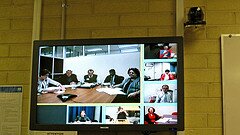The Benefits may be great, but the disadvantages of video conferencing may be just enough to disappoint those who depend on it for day to day activities.
No product or idea is perfect, and always has room for improvement . . . even video conferencing. This is realized when you read the history of video conferencing. You can see how it started, where it is now, and where it is going.
Many notice the following disadvantages on a day to day basis:
Personal Aspect - many feel that video conferencing takes away from the personal aspect of the conversation.
Rather than actually being in the atmosphere of the presenter or other party, you are in your surroundings which may limit how effectively you retain information.
Time Zone - Depending on where you are in the world it may be difficult to get everyone on the same page when scheduling a session.
When a session is scheduled for the evening in the United States, it may be 3:00 in the morning in Australia. This may be very inconvenient for those with strict work schedules.
Extra Training - If you have special equipment or are using a special program, you have to make sure those involved are properly trained on how to use the equipment.
Free Systems - Usually if you try to bypass paying for an expensive system by using a free multipoint service, you may be limited to how many participants you can have at once.
One disadvantage is the:
1. High Price.

One of the major disadvantages of video conferencing: expense - You may think that you save money, for example on travel expenses. However, that same money you save may have to be used to purchase and maintain the equipment.
This will vary based on which system you use. These systems can cost anywhere between $250 and $300,000. If you have a small business or organization you may see this as a steep price.
You would rather get a webcam for around $30 - $50 and a microphone and use a video chat network. If you're the decision maker of a business whose size is larger scale, $300,000 may be just a drop in the bucket considering what you would save.
You may have a need to fly employees out of the country and pay for accomodations to facilitate important meetings. Every situation is different.
Another disadvantage would be the:
2. Stability of your connections

Complex Technology - Technology isn't always trustworthy. In the middle of an important session you may be disconnected at any given time and have to wait to be reconnected (unlike meeting in person).
One thing that doesn't happen when meeting people in person is being disconnected. This typically happens on free or very inexpensive equipment.
Therefore, free or very inexpensive equipment may not be suitable for businesses, educational facilities or hospitals. When important issues relating to those industries are involved you need quality equipment.
A third issue could be:
3. Limited to a certain number of users at the same time (depending on the system/program you use).

Free Systems - Usually if you try to bypass paying for an expensive system by using a free multipoint service, you may be limited in how many participants you can have at once.
This is usually the case on free systems and is sometimes okay for social chatting. However, it is not good for meetings involving groups of people.
A fourth issue can be is:
4. Audio quality with large groups.

Audio Clarity - It may be very difficult to hear the presenter if they don't have a microphone or they aren't near the microphone or camera provided. In addition you would need good quality speakers to hear a class of a big size.
Video Clarity - Video Conferencing uses more bandwidth than audio conferencing, therefore there are chances of video being of less quality than audio.
If you don't have decent audio equipment it may be difficult to hear certain people in Question and Answer sessions in a group discussion. The reason is because the futher away someone is from the microphone the harder it may be to hear them.
This points out why it is also important to have good speakers and microphones. In a meeting, hearing what's being said is more important than seeing what's being said and not being able to understand.
You will continue to find more disadvantages of video conferencing as you continue to communicate this way. However, for some purposes the above mentioned concerns are less of an issue. You will need to assess these points for your particular needs.
It may be appropriate to begin with a trial period with a less expensive solution so that your organization can assess the importance of the issues, the costs and potential savings, and the viability of using video conferencing in place of face to face meetings. Consider where it may be appropriate and where it would not be suitable.
A topic that is related to "disadvantages of video conferencing" is Disadvantages of Distance Learning, check it out, too.